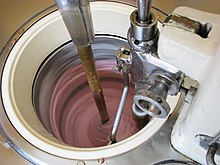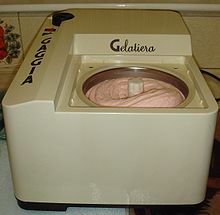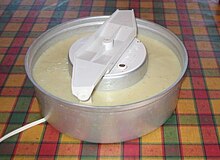Ice machine
An ice machine is a device for the production of ice cream , in the broader sense also for the production of ice cubes and ice for cooling purposes.
Ice cream maker
Ice cream is made with an ice cream maker. As a large-scale device, it is also known as the freezer . In addition to freezing , the freezer adds air to the starting liquid, the so-called mix, the so-called overrun or overrun. The heat is extracted from the mix with a cooling machine . The heart of the freezer is a double-walled cylinder, the jacket of which forms the evaporator of the refrigeration machine and the interior of which absorbs the air-enriched mix. The ice that freezes on the cylinder wall is scraped off by the so-called impact shaft, a wall-mounted agitator.
Ice machines for private households are also available in a variant in which the heat is extracted from the ice mixture by a cooling battery that has previously been pre-cooled in the freezer compartment of a refrigerator or freezer. It is driven by a crank or an electric motor. Ice machines are also available as accessories for kitchen machines . Ice makers that only stir must be placed in the freezer.
Popsicle ice cream or popsicle is made in two ways. With the round freezer, the pumpable ice cream is pressed into molds and the stick inserted from above. The molds are driven through a cooling liquid, the brine, to make the ice hard. The second type of production is extrusion . The stick is pushed into the extruded ice strand and the strand is cut. Coatings are made by briefly dipping into the molten coating, e.g. B. Chocolate applied.
Ice cakes are handcrafted from pumpable ice cream, decorated and then frozen.
For the soft ice cream process, see soft ice cream .
Ice for cooling purposes
Flake ice maker
A flake ice maker, also known as ice flake maker, produces round, granular and pourable ice ( flake ice ), which is used, among other things, for the storage and transport of edible fish , in the laboratory and in medicine .
Scale ice maker
Flake ice produce flat-flowing ice ( flake ), which is used for different cooling processes, for example in food manufacturing. These are about 1 - 2 mm thick, up to −7 ° C cold ice flakes that form on a roller that is also the evaporator of a refrigeration machine.
Flake ice is used to make scalded and cooked sausages and bread dough. The fish counters in supermarkets are also often filled with flake ice. Fish and seafood can be transported chilled on or in the ice bed or presented attractively for sale. Flake ice can be handled and dosed with a chute. If stored in a cool place, it remains pourable. It is also suitable for numerous other applications, e.g. B. in cold buffets, in the food industry for the presentation of goods and on fishing ships to keep the fish fresh.
Ice cubes
Ice cube makers produce pieces of ice (" ice cubes ") of a defined size that are used for ice drinks, for example. They consist of a refrigeration machine with a switchable refrigerant circuit, so that the frozen pieces can be periodically thawed and separated. The pieces of ice form around chilled pens or in chilled bowls which, open at the bottom, are sprinkled with water.
The periodic heating loosens the ice pieces and drops them into a storage container. For this purpose, the refrigerant circuit is switched with valves in such a way that the otherwise cooling evaporator briefly works as a condenser and therefore heats up.
Historic ice cream factories
Before electric refrigerators became widespread in households, ice boxes were used to store food to be cooled. They needed a block of ice weighing a few pounds to keep them cool for a few days. The ice blocks were produced centrally in ice factories with large ammonia refrigeration machines and delivered to customers. See also Eismann .





